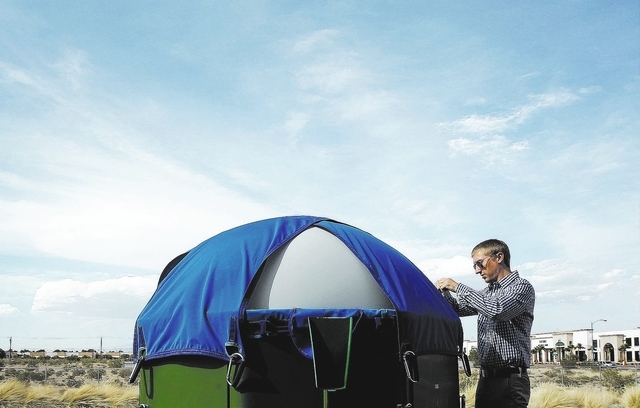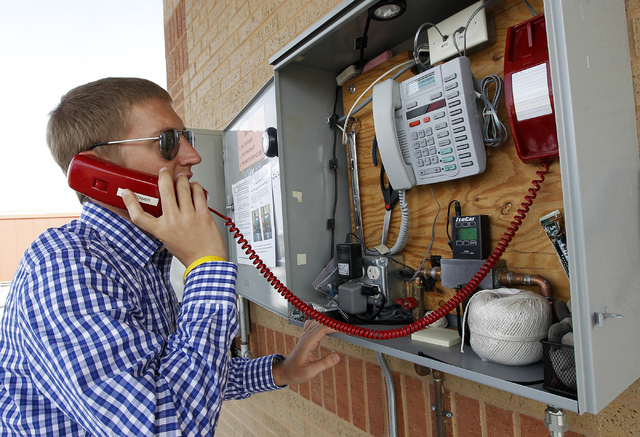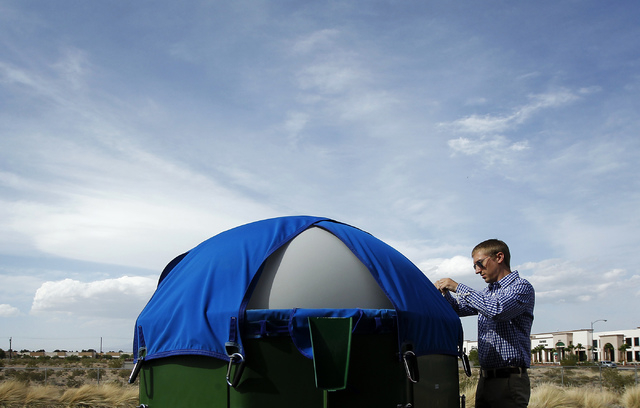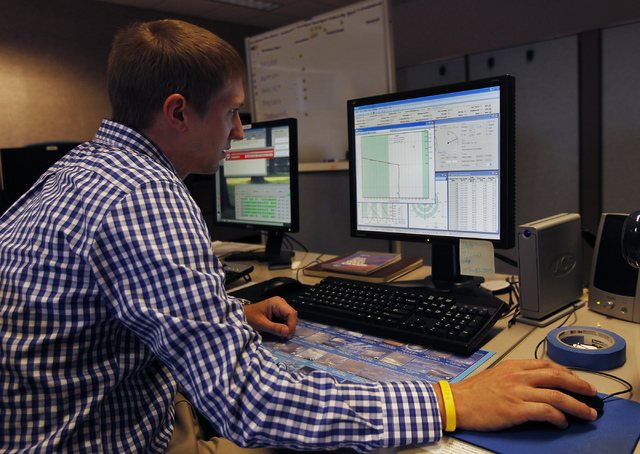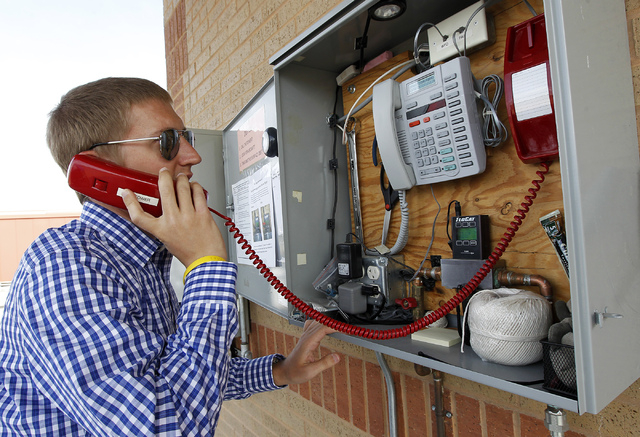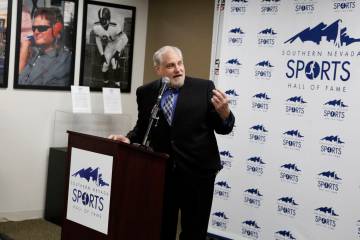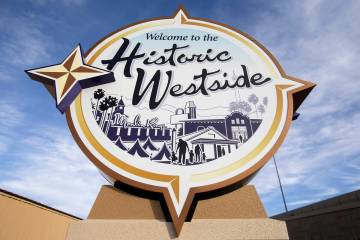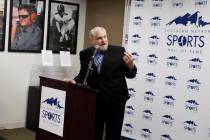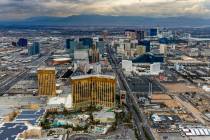Like your weather app? Thank a Las Vegas meteorologist
A bright red phone sits in the middle of a room within a small cinder block building in the southwest corner of the Las Vegas Valley.
Chris Stumpf picks up the phone at precisely 2:55 p.m., says a few words and heads outside.
The red phone didn’t call the police. It didn’t call the military or the president of the United States. It called the airport control center, and Stumpf is going outside to release a balloon into very busy airspace.
Stumpf is a National Weather Service meteorologist. He, with 16 other meteorologists at the Las Vegas weather forecast office near the Silverton hotel-casino, keeps an eye on the weather conditions of nearly 70,000 square miles of southwest valley land. The National Weather Service is a federal agency under the the National Oceanic and Atmospheric Administration, and its goal is to forecast weather to protect life and property. The Las Vegas office covers Southern Nevada, eastern California, western Utah and Mohave County in Arizona.
And while all of their gadgets may look straight out of a science fiction movie, your favorite weather app wouldn’t work without them.
The meteorologists who work for the weather service spend their days reading charts, reports and gauges. They generate graphics and manage social media. They issue watches and warnings. And whoever is on shift at 2:55 p.m. or a.m. — or 3:55 during daylight saving time — picks up the red phone and calls McCarran International Airport to let them know a weather balloon is about to be released 100,000 feet into the air.
Out of the three meteorologists on shift, it is Stumpf’s turn. He attaches a floppy balloon to a helium tank and fills it up to a diameter of about 6 feet. It’s tethered to the ground in a small corral, so it can’t float away prematurely. As the balloon fills, Stumpf ties on a long string.
When the balloon reaches the full diameter, he takes it out of the corral, walks it away from the building and ties the string to a small plastic foam box. The box, fewer than 6 inches on any side, contains a radiosonde, which will transmit temperature, pressure and humidity statistics by GPS back to the forecast office.
More than 100 forecast offices across the world release balloons at the same time each day to get an overall picture of the weather.
Stumpf makes sure the box is secured, then he releases the balloon.
It rises, pulling the string and box behind it. As it climbs more than 1,000 feet per minute and the air pressure changes, Stumpf said, it will grow until it’s about 50 feet in diameter. When the balloon finally pops, it probably will be about 20 miles above the ground.
The popped balloon and box will land somewhere, and if a person finds it, they can mail it back to the weather service by using the self-addressed bag inside. Stumpf said one was recently returned by McCarran airport after it landed on one of its runways.
According to NOAA statistics, less than 20 percent of the 75,000 radiosondes released in a year are returned.
Not everything a meteorologist does is as hands-on, but it still makes a difference to the community and in people’s daily lives.
A lot of the day is spent sitting at a computer station, deciphering charts, making graphics and posting the weather reports we all rely on. Colorful maps, gray-scale topography and numbers that would leave an untrained eye confused fill their computer screens.
As Las Vegas meteorologist Clay Morgan put it, “Weather affects everyone, every day — whether I wear a jacket or not, or if I’m going to be in a life-and-death situation in the next 20 minutes.”
Morgan has been a meteorologist for more than 20 years and at the Las Vegas forecast office for 11 of them. The payoff for him is long term — after weeks of tedious and unchanging weather, something drastic will happen and get his adrenaline pumping.
“That’s why I put up with the day-to-day stuff,” Morgan said. “It’s the big ‘boom’ that makes it all worth it.”
For Morgan, that boom was a tornado in Mississippi in 2001. A girl heard Morgan’s forecast of a tornado and told her mother, who frantically knocked on neighbors’ doors. After the whole neighborhood was evacuated, it was flattened by a tornado.
“Just to find out I made a difference,” Morgan said. “That tornado was my biggest career highlight.”
Some meteorologists find other ways to keep themselves occupied.
Andy Gorelow at the Las Vegas forecast office is training to become an IMET, or incident meteorologist. IMETs are certified through virtual classes and field training and are deployed to disasters that require hour-to-hour weather forecasts, such as wildfires, hurricanes and the BP oil spill in 2010.
Mainly, IMETs go to wildfires, such as the one last summer in the Spring Mountains west of Las Vegas.
“Carpenter 1 was crazy,” Gorelow said. “The warm weather rising above the fire actually created huge plumes of clouds. If that isn’t weather, I don’t know what is.”
Gorelow learned to forecast the smallest of wind shifts to keep firefighters safe while they were in the the burn area.
Helicopter pilots and ground crews were directed by IMETs during and after the fire to help heal the burned mountain range. Taking wind measurements, the IMETs guided helicopters that dumped thousands of pounds of hay on the ground to keep the uprooted soil down. The safety of people involved in all of those situations depends on wind.
According to the crew at the Las Vegas office, the forecast for five days out is more accurate than the next-day forecast was 10 years ago. Technology has digitized and automated almost everything, and everyone at the office agreed that social media have made things even better, especially for simple forecasts or emergencies.
However, not everything is technology-based. The Las Vegas office’s official measuring tool for snowfall is a piece of poster board wedged under a rock. With the valley’s scarce snowfall, it’s more of a “yes it snowed” or “no it didn’t” process, rather than a numerical measurement.
Even on quiet weather days that don’t involve wildfires, computers beep, alarms chirp and radios hum with static as camera feeds and weather charts display on large TV screens at the front of the room. And no matter what time of day it is, there’s a meteorologist sitting in that office, making sure the forecast you check on your computer or phone throughout the day is correct.
Contact reporter Annalise Porter at aporter@reviewjournal.com or 702-383-0391



